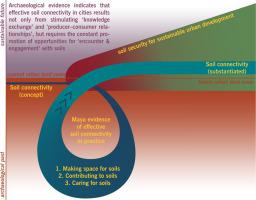Geoderma ( IF 5.6 ) Pub Date : 2021-01-22 , DOI: 10.1016/j.geoderma.2020.114925 Daniel L. Evans , Benjamin N. Vis , Nicholas P. Dunning , Elizabeth Graham , Christian Isendahl

|
Soils are a pivot of sustainable development. Yet, urban planning decisions persist in compromising the usability of the urban soils resource. Urban land cover expansion to accommodate an increasing population results in soil sealing. Concealment of and physical obstructions to soils prevent urban populations from engaging with their soil dependency. The concept of soil connectivity recognises that nurturing mutually beneficial soil–society relations is an essential dimension for achieving soil security. The concentrated populations of urban environments acutely require productive soil–society relations and offer the greatest potential for enhancing soil connectivity. Soil connectivity remains notably under-researched, however, resulting in deficient evidence to substantiate exactly how soil connectivity can contribute to sustaining urban life. The entanglement of soil and urban development has been critical throughout history, but seldom recognised in soil security discourse. We review the manifestation of effective soil connectivity in Precolumbian lowland Maya tropical urbanism. Archaeological evidence reveals, first, that lowland Maya urban settlement patterns largely preserved the availability, proximity, and accessibility of soils in the subdivision and configuration of urban open space. Second, Maya urban life included practices that proactively contributed to the formation of soils by adding to the stock of soils and improving beneficial soil properties of the thin and often nutrient-poor soils resulting from the regionally dominant karstic lithology. Third, a range of Maya landscape modifications and engineering practices enabled the preservation and protection of soils within urban environments. We derive evidence-based insights on an urban tradition that endured for well over two millennia by incorporating intensive soil–society relationships to substantiate the concept of soil connectivity. Inspiring urban planning to stimulate soil connectivity through enhancing the engagement with soils in urban life would promote soil security.
中文翻译:

隐藏的解决方案:Maya城市生活如何充实土壤的连通性
土壤是可持续发展的关键。然而,城市规划决策仍然在损害城市土壤资源的可用性。城市土地覆盖的扩大以适应不断增加的人口,导致土壤封闭。对土壤的隐蔽和物理障碍阻止了城市人口参与其对土壤的依赖。土壤连通性的概念认识到培育互利的土壤社会关系是实现土壤安全的重要方面。人口密集的城市环境迫切需要有效的土壤社会关系,并具有增强土壤连通性的最大潜力。土壤连通性的研究仍很不足,但是,缺乏足够的证据来证实土壤连通性如何有助于维持城市生活。在整个历史中,土壤与城市发展的纠缠一直很重要,但在土壤安全论述中很少得到认可。我们回顾了前哥伦比亚低地玛雅热带都市主义中有效土壤连通性的表现。考古证据表明,首先,低地玛雅人的城市居住模式在很大程度上保留了可利用性,邻近性,城市开放空间的细分和配置中土壤的可及性。其次,玛雅人的城市生活包括通过增加土壤资源量和改善由地区占主导地位的岩溶岩性引起的稀薄且经常缺乏营养的土壤的有益土壤特性,来积极促进土壤形成的实践。第三,一系列的Maya景观修改和工程实践使城市环境中的土壤得以保存和保护。通过结合深入的土壤社会关系以证实土壤连通性的概念,我们得出了对长达两个千年之久的城市传统的循证见解。通过加强城市生活中与土壤的接触,激发城市规划以促进土壤连通性,将促进土壤安全。











































 京公网安备 11010802027423号
京公网安备 11010802027423号